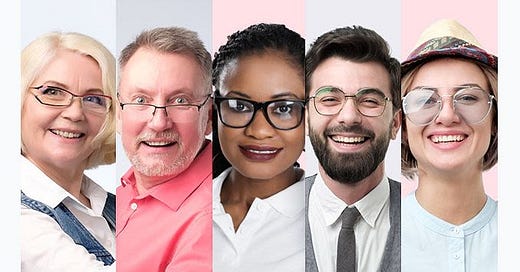The Curb Cut Effect: When Making Things Accessible to People With Disabilities Helps Everyone
What will be the next accessibility feature to make it to curb cut status? That's up to us
[This is a shorter, more up-to-date rewrite of a post that appeared on the previous iteration of this blog on Medium].
Behold, the curb cut: a wedge cut into an elevated curb to allow smooth passage between the sidewalk and the street.
Curb cuts were originally designed to make public streets accessible to wheelchair users. One of the first in the U.S. was installed in Michigan in 1945, to help disabled World War II veterans.
Today, everyone benefits, whether or not they have a physical disability.
Curb cuts have helped you if you’ve ever:
pushed a stroller,
carried heavy bags,
had joint pain,
walked with crutches or a cane,
or stumbled around drunk.
When I suffered from a long bout of knee tendinitis that made walking on uneven surfaces painful, curb cuts made walking between home and school bearable.
In short:
Technology designed for people with disabilities often helps everyone. This principle is called the “curb cut effect.”
So, why are curb cuts an invisible part of everyone’s public space, while closed captions, hearing aids, canes, and other assistive technology stand out as being “for people with disabilities?”
Assistive technology seems “normal” when enough people use it

Curb cuts are destigmatized because they clearly support so much of the population. At any time, anyone can break a leg or need to push a baby in a stroller.
Similarly, eyeglasses draw very little stigma — most likely because today, 62%, or almost 2/3, of American adults wear glasses. (More specifically, the US Census Bureau found they wore some sort of glasses or contacts in the past 3 years). With the majority of people using glasses, they’ve become common enough to fall within the range of “normal” human variation.
Assistive technology seems “normal” when it becomes easy enough to access

Although we stigmatize neither curb cuts nor glasses, we think of them differently. We forget that curb cuts began as accommodations for disabled people. However, we still see glasses as assistive technology for people with nearsightedness or astigmatism.
Why do we view curb cuts and glasses differently?
The difference between glasses and curb cuts is that glasses are prescribed by specialist doctors for certain eye conditions, while curb cuts are easily available to anyone, anytime.
When we see a technology as “assistive” in nature, we provide it only to people with disabilities—often after a lengthy qualifying process involving trained professionals. Thus, people without disabilities may not know how to access it at all.
Unfortunately, relegating technologies to people with disabilities creates a stigma.
People without disabilities avoid the technology because they don’t want to be associated with disabilities or be seen as disabled.
This stigma is strong enough to make otherwise-promising technology fail. For example, blind writer Will Butler persuasively argues that Google Glass failed to catch on (in part) because it looked like assistive technology.
What will be the next curb cut?
![Screenshot of a frame of Star Wars showing R2D2 with the closed caption "[sad beep]" Screenshot of a frame of Star Wars showing R2D2 with the closed caption "[sad beep]"](https://substackcdn.com/image/fetch/$s_!Qx2u!,w_1456,c_limit,f_auto,q_auto:good,fl_progressive:steep/https%3A%2F%2Fsubstack-post-media.s3.amazonaws.com%2Fpublic%2Fimages%2F6fb55bc8-456b-4aad-beb2-d4f857c15a3f_564x245.jpeg)
Two related types of assistive technology have immense potential to become the next “curb cut”: closed captions and transcripts of audio and video.
Like curb cuts, these technologies can help anyone, not just people with disabilities. When made available, they are also easy to access and use. Thus, a group of researchers believes we can make closed captions and transcripts completely like curb cuts.
“Many people associate the use of closed captions and transcripts only with disability accommodation, and that can mean they are not made widely available,” said Katie Linder, director of the Oregon State University Ecampus Research Unit and author of the study. “One hope for this study was to help educate university administrators about how a range of students are using these tools, and that making them more available could help more learners.”
Like curb cuts, closed captions and transcripts don’t require specialized fitting to an individual’s needs by a trained professional. That makes them good candidates for destigmatizing.
To destigmatize closed captions and transcripts, we would need to communicate that they are for everyone, not “just for people with disabilities.” We’d also need to prove it by making them effortlessly available everywhere, just as curb cuts are.
I propose that, by destigmatizing assistive technologies and making them ubiquitous, we can turn them into devices that— like curb cuts— help everyone.
What do you think?
What technology do you think could, with a little effort, become like glasses (common and destigmatized) or curb cuts (universally available)? Are there any limits to what technology can become a curb cut?
What assistive technology would you most like to see turn into a “curb cut?”






I am hearing impaired & have love that closed captioning is now so easily accessed. My daughter, whose hearing is fine, also has it on her tv all the time. It’s easier to follow when several characters overlap speaking.
Next good thing is the opposite. Reading to me (thanks Substack). I love to read. I want to know everything. I can’t sit on the couch all day to read! But I can choose my articles & have them read to me- blue-toothed right into my tiny, invisible hearing aids! So I can be learning everywhere! The rest of y’all will have to get very obvious earbuds, sorry. But worth it!
New haptic hearing suits designed for the def are actually an incredible experience for everyone that will actually evolve music theory in such a huge leap that it will be akin to the development of electronic music.
https://www.npr.org/2023/07/17/1186173942/vibrating-haptic-suits-give-deaf-people-a-new-way-to-feel-live-music